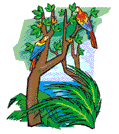Seedless Plants
A lesson and worksheet on seedless plants.
Objectives:
• Students will be able to name the two types of plants without seeds and distinguish one from the other.
• Students will be able to describe how plants without seeds produce new plants.
• Students will understand the role of mosses in the re-growth of damaged forest areas.
Suggested Grades:
3rd Grade - 4th Grade - 5th Grade
Print the reading comprehension worksheet passage and questions (see below).
Students should read the passage silently, then answer the questions. Teachers may also use the text as part of a classroom lesson plan.
Lesson Excerpt:
Most of the plants you see around you grow from seeds. However, some plants do not have seeds. There two types of plants with no seeds: seedless nonvascular plants and seedless vascular plants. The words vascular and nonvascular refer to whether or not the plant has a tube-like structure that absorbs water. Both types of seedless plants have similar lifecycles, but their structures are different.
Nonvascular seedless plants cling to damp soil, rocks and the shady sides of trees. One example of this kind of plant is moss. Moss does not have roots, but it does have structures like tiny hairs that help it stay anchored in one place. These structures are fibers called rhizoids. Instead of seeds, moss, like all seedless plants, grows from spores. The spores of seedless plants are very tiny. They are contained in capsules until the capsules burst and the spores spray out. Spores that land on soil in the right conditions grow into new plants.
Continued...

Lesson Printables:
Print this printable worksheet for this lesson:


